人教高中英语必修四Unit 4 body language warming up and Reading课件(46张ppt)
文档属性
| 名称 | 人教高中英语必修四Unit 4 body language warming up and Reading课件(46张ppt) | 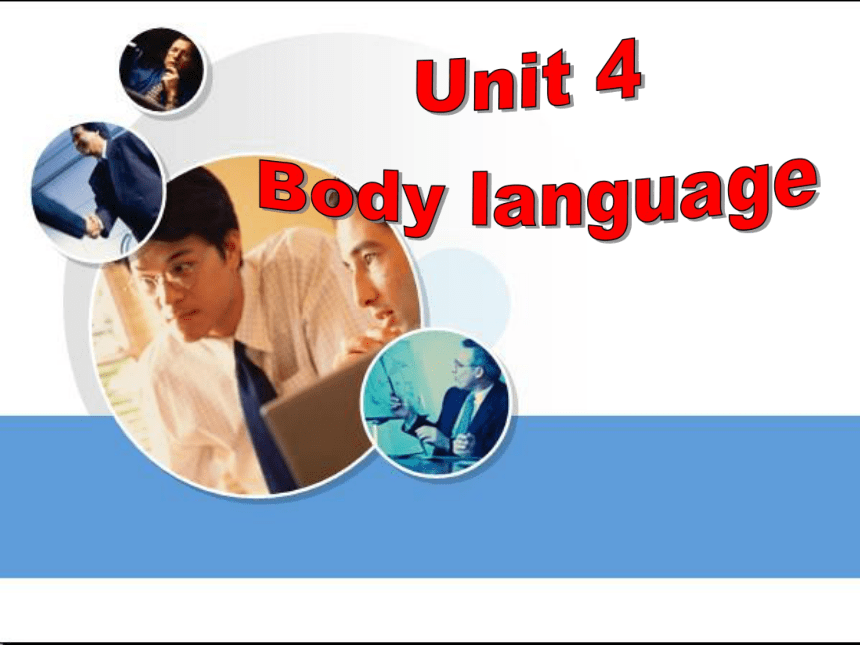 | |
| 格式 | zip | ||
| 文件大小 | 5.7MB | ||
| 资源类型 | 教案 | ||
| 版本资源 | 人教版(新课程标准) | ||
| 科目 | 英语 | ||
| 更新时间 | 2019-06-17 18:08:56 | ||
图片预览

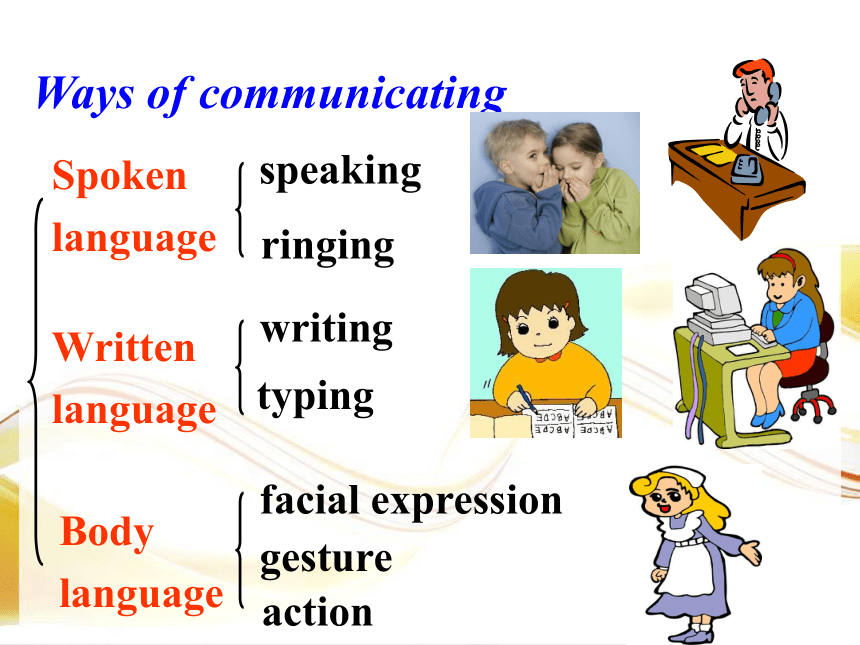
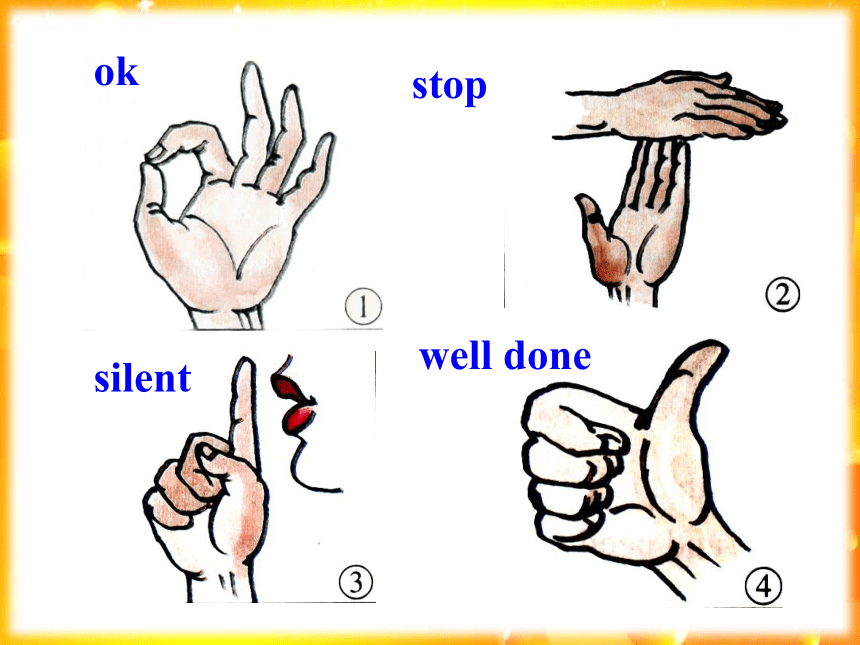
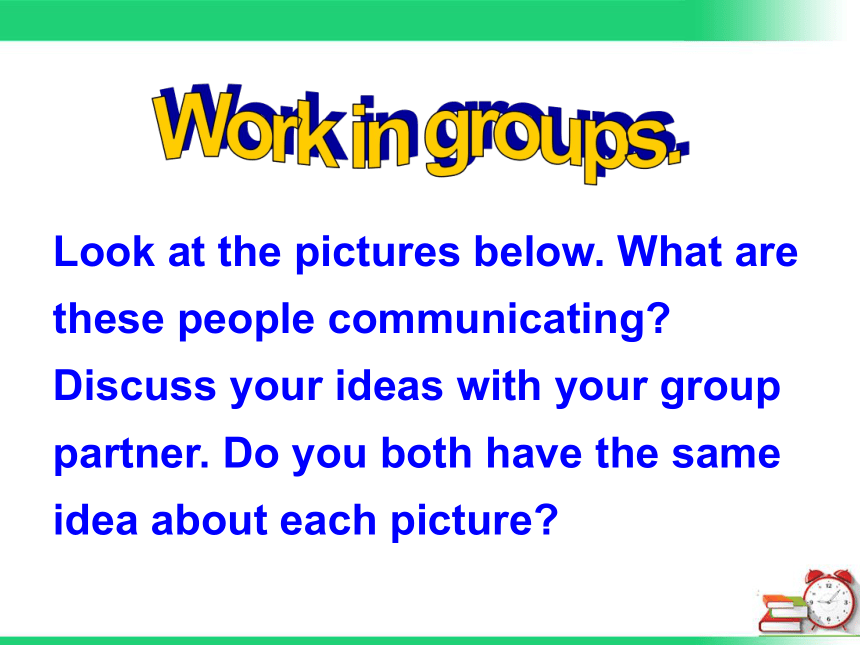
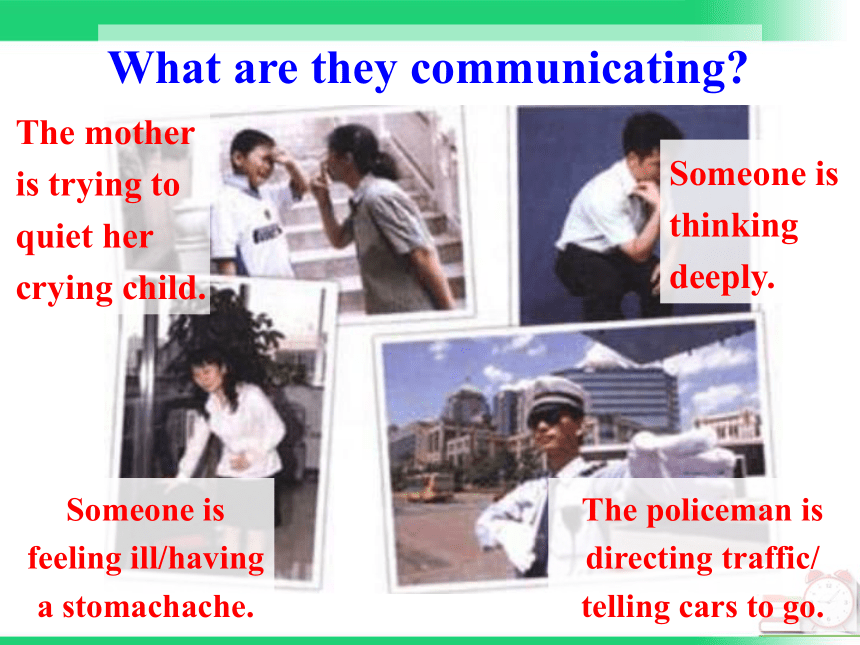



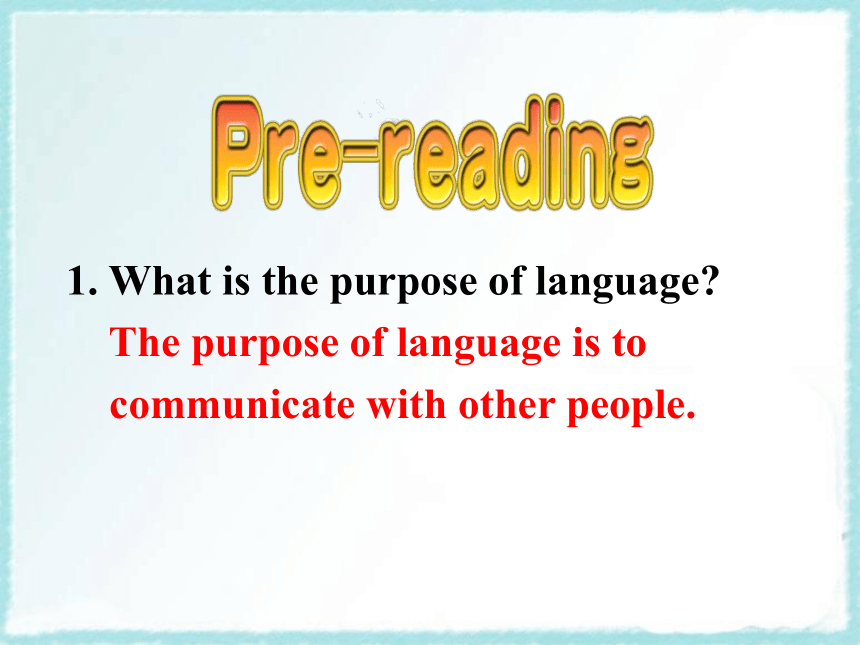
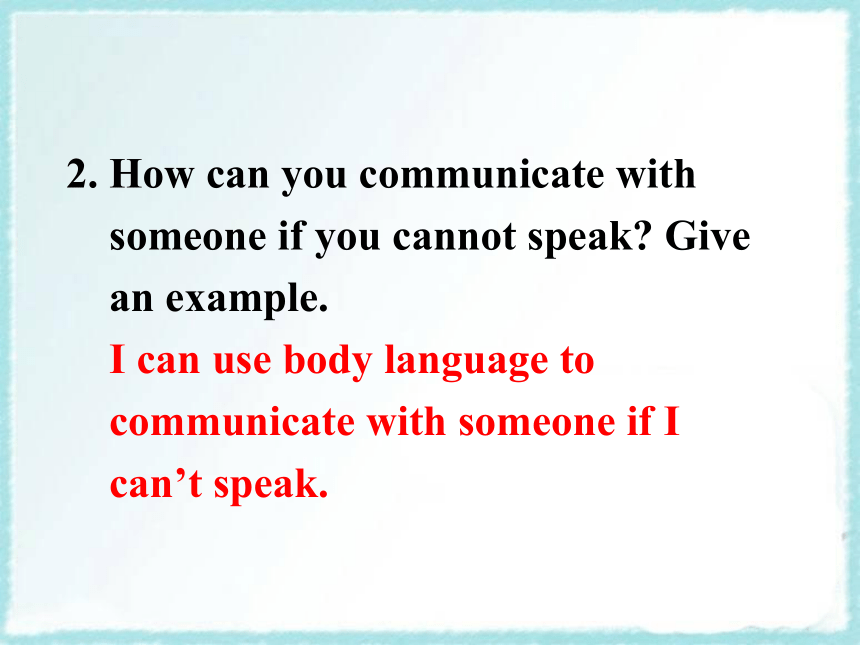

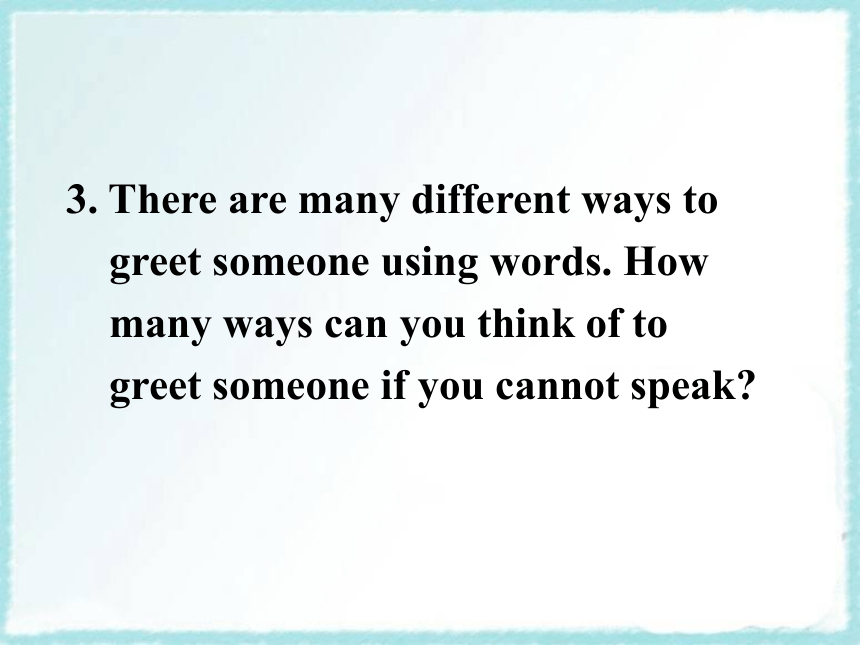
文档简介
speaking
ringing
writing
typing
Spoken
language
Written
language
Body
language
Ways of communicating
gesture
facial expression
action
ok
stop
silent
well done
Look at the pictures below. What are these people communicating? Discuss your ideas with your group partner. Do you both have the same idea about each picture?
What are they communicating?
The mother is trying to quiet her crying child.
Someone is thinking deeply.
Someone is feeling ill/having a stomachache.
The policeman is directing traffic/ telling cars to go.
Read the following statements. Choose a phrase and act it out without speaking. Can your partner guess what you are trying to communicate?
“Hello” “Goodbye” “Come here”
“Go away!” “Expensive!”
“I’m surprised!” “I’m tired.”
“I’m confused.” “OK!”
“Good luck!” “I’m delighted!”
“I’m upset!” “I’m sad!”
“I forgot!” “You’re great!”
1. What is the purpose of language?
The purpose of language is to
communicate with other people.
2. How can you communicate with
someone if you cannot speak? Give
an example.
I can use body language to
communicate with someone if I
can’t speak.
For example, if I’m angry, I might turn away and not talk to others. If I’m happy to see someone, I might smile and hold out my hand or open my arms.
3. There are many different ways to
greet someone using words. How
many ways can you think of to
greet someone if you cannot speak?
Ways to greet someone without words:
smile, wave, shake hands, hug, kiss, etc.
handshake
kiss
bow
hug
Predicting
Look at the picture and the title of the passage on page 26.
What do you think the topic will be?
Read the text quickly and fill in the blanks.
?????? The text introduces some examples of _____________ in greeting people to tell readers that in order to avoid difficulties we should study ____________________ in today’s world of cultural crossroads.?
body language?
international customs
Read the passage and divide the
whole passage into several parts
and find out the main idea.
Part 1. (Para. 1)
Meet the visitors at the airport.
Part 2 (Para. 2 and 3)
People from different countries express greetings in different ways.
Part 3. (Para. 4)
Different peoples have different body languages.
Part 4. (Para. 5)
Summary of body language.
How do different international
students behave when they greet
people? Complete the chart with
information from the passage.
man from Colombia
kiss on the cheek
Julia Smith
woman from Britain
everyone
Akira Nagata
bowing
everyone
Name Description Body Language To Whom
Tony Garcia everyone
no touching
man from Japan
man from Canada
shaking hands
everyone
Ahmed Aziz
man from Jordan
shaking hands
nodding
Darlene Coulon
woman from France
people she knows
Name Description Body Language To Whom
George Cook
to men
to women
shake hands and kiss twice on each cheek
shake hands, do not stand very close to others or touch strangers when they meet
shake hands
bow
Country/Area Ways to greet each other
Britain
Canada
Japan
approach others closely
and are more likely to
touch them
shake hands and kiss each other twice on each cheek
Spain, Italy, South American countries
France
shake hands and stand quite close to other men, nod to women and do not shake hands with them
(men from) Middle East and other Muslim cultures
Read the text and decide whether the following statements are True (T) or False (F).
1. The author went to the airport to
observe the people's behaviours.
2. Julia did not like the way Tony greeted
her.
3. George thought Akira would shake
hands with him.?
F
T
T
4. The author intended to stand close to
Ahmed.
5. Muslim people like to stand close to
each other and touch.
6. People like to keep their distance and
shake hands in South America.
F
F
F
1. Is the author of this passage male or female? How do you know?
The author is male. Ahmed Aziz will not shake hands with women, but he shakes hands with the author.
Answer the following questions.
2. What were the two mistakes that the
author noticed?
He noticed that the Colombian man kissed the British woman, but in her culture, a kiss from a stranger is not acceptable. He also noticed that the Japanese man bowed just as the Canadian man started to shake hands, so one man’s nose touched the other man’s hand.
3. Who seemed to prefer to keep more physical distance from others? Who seemed to prefer closer physical distance?
The British woman, Julia, and probably
the Canadian man, George, seemed to
prefer to keep more physical distance from others. The Colombian man, Tony, and the Jordanian man, Ahmed, seemed to prefer closer physical distance.
4. Did any students have similar greeting customs? If so, which ones?
Yes. Tony from Colombia and Darlene from France had a similar greeting custom—a kiss. George from Canada and Ahmed from Jordan also had a similar greeting custom—a handshake, but Ahmed shakes hands only with men.
5. “When in Rome, do as the Romans do.” What do you think this famous saying means?
This saying means that when we are in a certain place, we should follow the customs of the people who live in that place, not our own customs.
6. Do you agree with the author’s statement that body language is not good or bad? Why or why not?
Open.
1. Englishmen often stand close to others or touch strangers as soon as they meet.
2. Most people around the world now greet each other by kissing.
Decide if the following statements
are true (T) or false (F).
F
F
3. Japanese will bow to others as greeting.
4. People from Jordan will move very
close to you as you introduce yourself to
them.
5. Some body languages in some countries
are good while some countries’ body
language are bad.
T
T
F
6. People from different countries may
have a major misunderstanding while
greeting each other.
7. The physical distance from each other
that people are comfortable with
generally depends on the culture.
8. All members of a culture behave in
the same way.
T
T
F
Close the book and choose the best answers.
1. In which of the following countries do people greet each other in the same way?
A. Jordan and Italy.
B. China and Japan.
C. Canada and Colombia.
2. From the text, we can know that _____.
A. people are likely to keep the same
distance in different countries
B. men from Britain often stand close
to others to shake hands
C. people are facing multicultural
communication problems
1. If you meet a foreigner who comes up
close to you to talk, what countries
might he be from? How can you show
him that you are uncomfortable with
that?
2. What are some situations where body language is the only form of communication? Why?
3. Discuss ‘Do you agree with the author’s statement that body language is not good or bad? Why or why not?’
Body language varies from culture to culture.
show interest
rude or
disrespectful
Gesture Country Meaning
eye contact some countries
other countries
zero
rude
money
OK
Gesture Country Meaning
a circle with one’s thumb and index finger most countries
Japan
France
Germany
Brazil
No.1
rude
great / good job
Gesture Country Meaning
thumbs up the US
Nigeria
Germany
Japan
No
Yes
Gestures countries Meaning
Shaking one’s hand
Bulgaria, parts
of Greece, Iran
Other countries
Greet
friends
France
Russia
Other countries
Gestures countries Meanings
Kiss on the
cheek
A firm
handshake
A loving hug
A bow / a nod
of head
Talk about body languages you usually use.
ringing
writing
typing
Spoken
language
Written
language
Body
language
Ways of communicating
gesture
facial expression
action
ok
stop
silent
well done
Look at the pictures below. What are these people communicating? Discuss your ideas with your group partner. Do you both have the same idea about each picture?
What are they communicating?
The mother is trying to quiet her crying child.
Someone is thinking deeply.
Someone is feeling ill/having a stomachache.
The policeman is directing traffic/ telling cars to go.
Read the following statements. Choose a phrase and act it out without speaking. Can your partner guess what you are trying to communicate?
“Hello” “Goodbye” “Come here”
“Go away!” “Expensive!”
“I’m surprised!” “I’m tired.”
“I’m confused.” “OK!”
“Good luck!” “I’m delighted!”
“I’m upset!” “I’m sad!”
“I forgot!” “You’re great!”
1. What is the purpose of language?
The purpose of language is to
communicate with other people.
2. How can you communicate with
someone if you cannot speak? Give
an example.
I can use body language to
communicate with someone if I
can’t speak.
For example, if I’m angry, I might turn away and not talk to others. If I’m happy to see someone, I might smile and hold out my hand or open my arms.
3. There are many different ways to
greet someone using words. How
many ways can you think of to
greet someone if you cannot speak?
Ways to greet someone without words:
smile, wave, shake hands, hug, kiss, etc.
handshake
kiss
bow
hug
Predicting
Look at the picture and the title of the passage on page 26.
What do you think the topic will be?
Read the text quickly and fill in the blanks.
?????? The text introduces some examples of _____________ in greeting people to tell readers that in order to avoid difficulties we should study ____________________ in today’s world of cultural crossroads.?
body language?
international customs
Read the passage and divide the
whole passage into several parts
and find out the main idea.
Part 1. (Para. 1)
Meet the visitors at the airport.
Part 2 (Para. 2 and 3)
People from different countries express greetings in different ways.
Part 3. (Para. 4)
Different peoples have different body languages.
Part 4. (Para. 5)
Summary of body language.
How do different international
students behave when they greet
people? Complete the chart with
information from the passage.
man from Colombia
kiss on the cheek
Julia Smith
woman from Britain
everyone
Akira Nagata
bowing
everyone
Name Description Body Language To Whom
Tony Garcia everyone
no touching
man from Japan
man from Canada
shaking hands
everyone
Ahmed Aziz
man from Jordan
shaking hands
nodding
Darlene Coulon
woman from France
people she knows
Name Description Body Language To Whom
George Cook
to men
to women
shake hands and kiss twice on each cheek
shake hands, do not stand very close to others or touch strangers when they meet
shake hands
bow
Country/Area Ways to greet each other
Britain
Canada
Japan
approach others closely
and are more likely to
touch them
shake hands and kiss each other twice on each cheek
Spain, Italy, South American countries
France
shake hands and stand quite close to other men, nod to women and do not shake hands with them
(men from) Middle East and other Muslim cultures
Read the text and decide whether the following statements are True (T) or False (F).
1. The author went to the airport to
observe the people's behaviours.
2. Julia did not like the way Tony greeted
her.
3. George thought Akira would shake
hands with him.?
F
T
T
4. The author intended to stand close to
Ahmed.
5. Muslim people like to stand close to
each other and touch.
6. People like to keep their distance and
shake hands in South America.
F
F
F
1. Is the author of this passage male or female? How do you know?
The author is male. Ahmed Aziz will not shake hands with women, but he shakes hands with the author.
Answer the following questions.
2. What were the two mistakes that the
author noticed?
He noticed that the Colombian man kissed the British woman, but in her culture, a kiss from a stranger is not acceptable. He also noticed that the Japanese man bowed just as the Canadian man started to shake hands, so one man’s nose touched the other man’s hand.
3. Who seemed to prefer to keep more physical distance from others? Who seemed to prefer closer physical distance?
The British woman, Julia, and probably
the Canadian man, George, seemed to
prefer to keep more physical distance from others. The Colombian man, Tony, and the Jordanian man, Ahmed, seemed to prefer closer physical distance.
4. Did any students have similar greeting customs? If so, which ones?
Yes. Tony from Colombia and Darlene from France had a similar greeting custom—a kiss. George from Canada and Ahmed from Jordan also had a similar greeting custom—a handshake, but Ahmed shakes hands only with men.
5. “When in Rome, do as the Romans do.” What do you think this famous saying means?
This saying means that when we are in a certain place, we should follow the customs of the people who live in that place, not our own customs.
6. Do you agree with the author’s statement that body language is not good or bad? Why or why not?
Open.
1. Englishmen often stand close to others or touch strangers as soon as they meet.
2. Most people around the world now greet each other by kissing.
Decide if the following statements
are true (T) or false (F).
F
F
3. Japanese will bow to others as greeting.
4. People from Jordan will move very
close to you as you introduce yourself to
them.
5. Some body languages in some countries
are good while some countries’ body
language are bad.
T
T
F
6. People from different countries may
have a major misunderstanding while
greeting each other.
7. The physical distance from each other
that people are comfortable with
generally depends on the culture.
8. All members of a culture behave in
the same way.
T
T
F
Close the book and choose the best answers.
1. In which of the following countries do people greet each other in the same way?
A. Jordan and Italy.
B. China and Japan.
C. Canada and Colombia.
2. From the text, we can know that _____.
A. people are likely to keep the same
distance in different countries
B. men from Britain often stand close
to others to shake hands
C. people are facing multicultural
communication problems
1. If you meet a foreigner who comes up
close to you to talk, what countries
might he be from? How can you show
him that you are uncomfortable with
that?
2. What are some situations where body language is the only form of communication? Why?
3. Discuss ‘Do you agree with the author’s statement that body language is not good or bad? Why or why not?’
Body language varies from culture to culture.
show interest
rude or
disrespectful
Gesture Country Meaning
eye contact some countries
other countries
zero
rude
money
OK
Gesture Country Meaning
a circle with one’s thumb and index finger most countries
Japan
France
Germany
Brazil
No.1
rude
great / good job
Gesture Country Meaning
thumbs up the US
Nigeria
Germany
Japan
No
Yes
Gestures countries Meaning
Shaking one’s hand
Bulgaria, parts
of Greece, Iran
Other countries
Greet
friends
France
Russia
Other countries
Gestures countries Meanings
Kiss on the
cheek
A firm
handshake
A loving hug
A bow / a nod
of head
Talk about body languages you usually use.
同课章节目录
